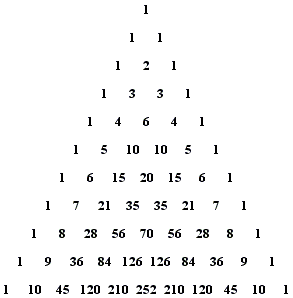Here's my code:
Code: Lbl 0
ClrHome
Menu("OPTIONS","ROW#",A,"BIONOMIAL THEOREM",B,"QUIT",C
Lbl A
Output(10,1,"ROW#≤69
Input "ROW:",C
If C≥70:Then
Output(10,15,"ERROR
Goto A
End
seq(C nCr X,X,0,C)→L₆
Disp L₆
Pause
Goto 0
Lbl B
ClrHome
0→D:1→K:1→Z:1→Y
"+→Str0
"X^→Str9
Output(4,1,"D(X+A)^B
Output(5,1,"B≤69
Input "A=",A
Input "B=",B
Input "D=",D
If B≥70:Then
Output(10,1,"ERROR
Goto B
End
If D=0:Then
Output(4,1,"EQUALS ZERO
Pause
Goto B
End
If D≠1:Goto 1
ClrHome
For(Q,0,B
(B!)/(Q!((B-Q)!))→N
Q-K→J
N(A^Q)→G
A^B→H
Fix 6
{0,1,2}→L₁
seq(BX²+JX+H,X,0,2,1→L₂
seq(JX²+HX+B,X,0,2,1→L₃
seq(HX²+BX+J,X,0,2,1→L₄
QuadReg Y₁
QuadReg L₁,L₃,Y₂
QuadReg L₁,L₄,Y₃
{0,1}→L₁
{0,J}→L₂
{0,H}→L₃
{0,B}→L₄
LinReg(ax+b) Y₄
LinReg(ax+b) L₁,L₃,Y₅
LinReg(ax+b) L₁,L₄,Y₆
EquString(Y₁,Str1
EquString(Y₂,Str2
EquString(Y₃,Str3
EquString(Y₄,Str4
EquString(Y₅,Str5
EquString(Y₆,Str6
sub(Str4,1,length(Str4)-3→Str4
sub(Str5,1,length(Str5)-3→Str5
sub(Str6,1,length(Str6)-3→Str6
sub(Str1,1,length(Str1)-(length(Str4)+length(Str5)+6)→Str1
sub(Str2,1,length(Str2)-(length(Str5)+length(Str6)+6)→Str2
sub(Str3,1,length(Str3)-(length(Str6)+length(Str4)+6)→Str3
If G≠1:Then
{0,G}→L₂
LinReg(ax+b) L₁,L₂,Y₁
EquString(Y₁,Str7
sub(Str7,1,length(Str7)-3→Str7
End
If B<20:Then
If not(Q):Then
Output(1,1,Str9+Str1
Y+length(Str9+Str1→Y
End
If Q=B:Output(Z,Y,Str0+Str3
If Q and Q≠B:Then
If (A^Q):Then
Output(Z,Y,Str0+Str7+Str9+Str2
K+1→K:Y+length(Str0+Str7+Str9+Str2→Y
End
If not(A^Q):Goto E
End:End
If B≥20:Then
If not(Q):Then
Output(1,1,Str9+Str1
Y+length(Str9+Str1→Y
End
If Q=B:Output(Z,Y,Str0+Str3
If Q and Q≠B:Then
If (A^Q):Then
Output(Z,Y,Str0+Str7+Str9+Str2
K+1→K:Y+length(Str0+Str7+Str9+Str2→Y
End
If not(A^Q):Goto E
End
If fPart(Z/10)=9:Then
Pause
10:Asm(prgmSHFTUP
1→Z
End
If Y>26:Then
(Y-26)+1→Y:Z+1→Z
End:End
Lbl E
Output(Z+1,1,"DONE
Pause
Float
Goto 0
Lbl 1
ClrHome
For(Q,0,B
(B!)/(Q!((B-Q)!))→N
Q-K→J
DN(A^Q)→G
D(A^B)→H
Fix 6
{0,1,2}→L₁
seq(BX²+JX+H,X,0,2,1→L₂
seq(JX²+HX+B,X,0,2,1→L₃
seq(HX²+BX+J,X,0,2,1→L₄
QuadReg Y₁
QuadReg L₁,L₃,Y₂
QuadReg L₁,L₄,Y₃
{0,1}→L₁
{0,J}→L₂
{0,H}→L₃
{0,B}→L₄
{0,D}→L₅
LinReg(ax+b) Y₄
LinReg(ax+b) L₁,L₃,Y₅
LinReg(ax+b) L₁,L₄,Y₆
LinReg(ax+b) L₁,L₅,Y₇
EquString(Y₁,Str1
EquString(Y₂,Str2
EquString(Y₃,Str3
EquString(Y₄,Str4
EquString(Y₅,Str5
EquString(Y₆,Str6
EquString(Y₇,Str7
sub(Str4,1,length(Str4)-3→Str4
sub(Str5,1,length(Str5)-3→Str5
sub(Str6,1,length(Str6)-3→Str6
sub(Str1,1,length(Str1)-(length(Str4)+length(Str5)+5)→Str1
sub(Str2,1,length(Str2)-(length(Str5)+length(Str6)+5)→Str2
sub(Str3,1,length(Str3)-(length(Str6)+length(Str4)+5)→Str3
If G≠1:Then
{0,G}→L₂
LinReg(ax+b) L₁,L₂,Y₁
EquString(Y₁,Str8
sub(Str8,1,length(Str8)-3→Str8
End
If B<20:Then
If not(Q):Then
Output(1,1,Str7+Str9+Str1
Y+length(Str9+Str1→Y
End
If Q=B:Output(Z,Y,Str0+Str3
If Q and Q≠B:Then
If (A^Q):Then
Output(Z,Y,Str0+Str8+Str9+Str2
K+1→K:Y+length(Str0+Str8+Str9+Str2→Y
End
If not(A^Q):Goto F
End:End
If B≥20:Then
If not(Q):Then
Output(1,1,Str7+Str9+Str1
Y+length(Str9+Str1→Y
End
If Q=B:Output(Z,Y,Str0+Str3
If Q and Q≠B:Then
If (A^Q):Then
Output(Z,Y,Str0+Str8+Str9+Str2
K+1→K:Y+length(Str0+Str8+Str9+Str2→Y
End
If not(A^Q):Goto F
End
If fPart(Z/10)=9:Then
Pause
10:Asm(prgmSHFTUP
1→Z
End
If Y>26:Then
(Y-26)+1→Y:Z+1→Z
End:End
Lbl F
Output(Z+1,1,"DONE
Pause
Float
Goto 0
Lbl C
Float
It's error free as far as I know. However, if I run it and click Binomial Theorem, with A=5,B=2,D=1, it should come out with X^2+10X+25 right? Nope, it just prints X^2. And Q=0 at the end. I don't understand why.
Help me find my error. Any optimization ideas are welcome because this is a lot of code. Thanks. 












